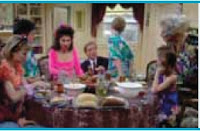 On this date in 1988, TV's original Brady Bunch reunited for what would turn out to be one of their highest-rated endeavors, and certainly, after the original series (1969-74) one of their most beloved.
On this date in 1988, TV's original Brady Bunch reunited for what would turn out to be one of their highest-rated endeavors, and certainly, after the original series (1969-74) one of their most beloved.Sure, there had been the campy variety show The Brady Bunch Hour in 1976, and the short-lived sequel series which launched with the double wedding of Marcia and Jan, The Brady Brides, in 1981. But it was A Very Brady Christmas that delivered huge ratings (inspiring CBS to bring back the bunch one more time in 1990, for a woefully conceived hourlong drama, The Bradys.) I remember gathering around the TV with my college hallmates for Christmas, all of us eager to see the Bradys step so far into the '80s.
 |
| Some Very Worried Bradys |
The Bradys are no strangers to resurrection, and who knows when will be the next time we see them all come together -- after all, apart from Reed, who died in 1992 at just age 59, the other eight original cast members, including Ann B. Davis as Alice, are still around and popping up in fun places. (Did you catch Henderson's hilarious cameo on 30 Rock a few weeks back? Priceless!) Here's what Knight, Henderson, Maureen McCormick (Marcia), Susan Olsen (Cindy) and even Geri Reischl ("Fake Jan" from the variety Hour) had to say about their groovy years growing up Brady.
Marcia Marcia Marcia!
The Brady Bunch Has Captivated Generation After Generation
It was the story, as The
Brady Bunch’s theme song famously explained, of a lovely lady, a man named
Brady, and the six kids who came together to form a blended family in groovy
1970s California. And it’s also the
story of how, even though the original Brady
Bunch was cancelled in 1974 after only five seasons, the show continued to spawn
spinoffs, merchandise, and movie and stage adaptations for decades. And that’s how they all became a true pop
culture phenomenon.
Created by Gilligan’s
Island impresario Sherwood Schwartz, The
Brady Bunch was one of the first shows to depict a blended family. In the sitcom’s pilot, divorcee Carol, along
with her three daughters, moves in with her new husband, the former widower
Mike Brady, and his three boys. Schwartz
seriously considered some famous names for these leads, including Gene Hackman
and The Mary Tyler Moore Show’s Joyce
Bulifant. And for the ninth member of
the Brady family, matronly housekeeper Alice, Schwartz initially favored
actress Kathleen Freeman.
In
casting the Brady kids, producers narrowed their choices to 3 blonde girls and
3 brunet boys -- and then vice versa, so that each set of kids would share the
same coloring as their TV parents yet to be cast. In the end, it was brunet
Robert Reed, formerly of the landmark early '60s legal series The Defenders, and blonde singer/actress
Florence Henderson who landed spots in the Bradys' famous opening credits grid.
In the center was Ann B Davis -- already a tv icon for her role as the
man-hungry Schultzie on ‘50s sitcom Love
that Bob -- as ever-faithful Alice.
“I was
a huge fan of Robert Reed’s from The
Defenders, and oh my gosh, he’s now my father!” recalls Maureen McCormick,
aka eldest Brady daughter Marcia. Susan
Olsen, who played the famously curly-haired young Cindy, adds, “And I was
so thrilled that I was going to be working with Schultzie.”
Henderson, too, credits the Bradys’ casting. “There was a chemistry we all had. We all felt very close to each other – and we
still do. That was a big part of the
show’s success.”
Groovy and Squeaky
Clean
Premiering in September of 1969, The Brady Bunch spanned from the Summer of Love through Watergate
and Vietnam, and yet its characters remained unabashedly square. The worst thing a Brady kid ever kid was get
caught with a pack of cigarettes in his varsity jacket; and even then, it
turned out they truly did belong to Greg’s friend. The show’s storylines revolved around
sanitized preteen traumas like first dates, invitations to school dances, and
general acts of sibling rivalry. In its
later seasons, to promote the cast’s own Partridge
Family-like touring musical act, the Bradys even competed in wholesome
local talent competitions.
“The show was a throwback,” remembers Christopher Knight,
who played middle Brady boy Peter. “We
were right in the middle of the disaster of Vietnam, and the country was coming
apart. In three years, I was going to
get drafted. And in the middle of all this
tumult, we were doing The Brady Bunch.”
But as Henderson recalls, in its troubled times, the show’s
gentle nature was a big key to its appeal.
“I always felt that The Brady
Bunch was like a wonderful children’s story, that you could read over and
over, because it was so loving.”
A Little Variety
In 1974, after five seasons, ABC called it quits on the
original Bunch – and some teenage
members of its cast, wary of going through more puberty on camera, were secretly
relieved. But two years later, NBC reunited
the family with a special, then a series, called The Brady Bunch Hour. This
trippy sequel of sorts – in which patriarch Mike Brady has ditched his
architecture practice and moved his clan to the beach, to put on
feathers-and-sequins variety numbers around a pool stocked with synchronized
dancers – capitalized on the Brady kids’ earlier musical popularity, and
Henderson’s rich career on TV variety shows and on Broadway.
But for the first of what would be several times in later
revivals, a Brady opted out. Producers
searched worldwide, auditioning over 3,000 girls – including Paris Hilton’s
mother Kathy Richards – to replace Eve Plumb as Jan.
They chose the appropriately teenage blonde singer and actress Geri
Reischl -- who to this day is lovingly referred to by Brady-ologists as “Fake
Jan.”
“I loved doing the disco numbers,” Reischl remembers, “and
working with the famous Brady family was like going to Disneyland every
day. I never saw it as going to
work.” Even someone more jaded about the
short-lived variety Hour, like the
admittedly disco-hating Olsen, had to admit it was enjoyable – to perform. “I was begging my friends at school not to
watch it,” Olsen admits. “Because the outcome was embarrassing,. But actually
making the show was loads of fun.”
Forever Brady
The Hour lasted
only a dozen or so weeks, as did NBC’s 1981 The Brady Brides, which saw Marcia and middle sibling Jan both
marry, with the couples now cohabitating.
In 1988, the Bradys reunited for a Christmas TV movie (this time, sans Olsen), the ratings
success of which inspired the development of The Bradys, a 1990 hour-long dramatic reincarnation, this time on
CBS. This time, for drama’s sake, the
Bradys had uncharacteristic problems.
Bobby was in a wheelchair. Marcia
drank – although as Olsen jokingly points out, “of course that was solved in an
hour.” Only Paramount Studios’ two 1990s
big-screen Brady adaptations, albeit
with a new cast, proved to be a hit with Brady-craving fans.
 Such fans still come up today, Knight says, and hope he’ll
utter Peter’s inadvertent catchphrase, “Pork chops and applesauce.” McCormick, too, is often reminded of Marcia’s
lines “Oh, my nose!” and “Something suddenly came up.”
Such fans still come up today, Knight says, and hope he’ll
utter Peter’s inadvertent catchphrase, “Pork chops and applesauce.” McCormick, too, is often reminded of Marcia’s
lines “Oh, my nose!” and “Something suddenly came up.”
The messages fans relay to her, McCormick says, "have always
been so good and so positive.” And Olsen
has a theory as to why new generations of fans continue to approach. “The
Brady Bunch is something you could grow up with. A girl could start out identifying with
Cindy, and end up identifying with Carol.”
Fans, Henderson says, like the show because “it was so
honest and so sincere. We really
believed in it, and worked so hard.” She
continues to receive fan letters from as far away as Russia, India and China,
and says the most common request she gets in person is simple: just a hug.
“It’s wonderful to have been a part of something that people love,” she
enthuses. “And so I have hugged people
around the world, and it’s a lovely feeling.”














.jpg)












